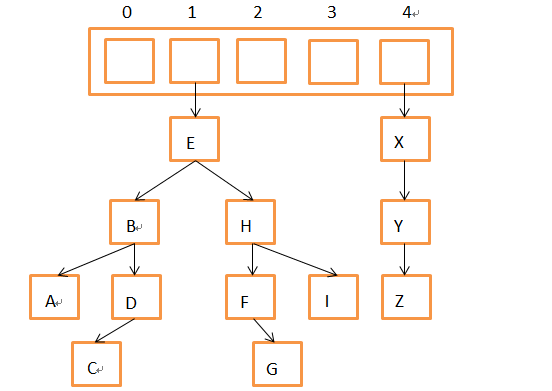jdk7

ConcurrentHashMap的put方法
1 public V put(K key, V value) { 2 Segment<K,V> s; 3 //在并发map中key、value均不能为null 4 if (value == null) 5 throw new NullPointerException(); 6 int hash = hash(key); 7 //j是segments中的index,定位segment,段用于提高并发度,更新时只在段内加锁,不影响其他段,segments的大小是ssize,ssize<=concurrencyLevel,且是2的n次方。 8 int j = (hash >>> segmentShift) & segmentMask; 9 //(j << SSHIFT) + SBASE是内存中第j位的segment在segments中的偏移量 10 if ((s = (Segment<K,V>)UNSAFE.getObject // nonvolatile; recheck 11 (segments, (j << SSHIFT) + SBASE)) == null) // in ensureSegment 12 //保证第j位segment的存在 13 s = ensureSegment(j); 14 //向第j位的segment存入key-value 15 return s.put(key, hash, value, false); 16 }
segment的put方法,segment可以看做是一个HashMap,但其并没有实现Map,Segment<K,V> extends ReentrantLock implements Serializable,可以看到segment继承了ReentrantLock,其更像是一把锁。
1 final V put(K key, int hash, V value, boolean onlyIfAbsent) { 2 //首先尝试获取锁,如果失败则不断扫描hash映射到的桶(以确定是否有相同的key,思想就是即便暂时没有获取到锁,也不要闲着,找些之后要做的事先做着),并尝试获取锁,当尝试获取锁的次数到达阈值,则lock。 3 HashEntry<K,V> node = tryLock() ? null : 4 scanAndLockForPut(key, hash, value); 5 //之后的逻辑都是在获得锁的前提下进行的 6 V oldValue; 7 try { 8 //segment其实是一个map结构(但没有实现Map接口),这里的table就类似于HashMap中的table 9 HashEntry<K,V>[] tab = table; 10 //index即桶的索引 11 int index = (tab.length - 1) & hash; 12 //取得桶中的首节点 13 HashEntry<K,V> first = entryAt(tab, index); 14 //循环逻辑类似HashMap,遇到相同的key就替换,遍历置尾节点仍没有找到相同的key则插入 15 for (HashEntry<K,V> e = first;;) { 16 if (e != null) { 17 K k; 18 if ((k = e.key) == key || 19 (e.hash == hash && key.equals(k))) { 20 oldValue = e.value; 21 if (!onlyIfAbsent) { 22 e.value = value; 23 ++modCount; 24 } 25 break; 26 } 27 e = e.next; 28 } 29 else { 30 if (node != null) 31 node.setNext(first); 32 else 33 node = new HashEntry<K,V>(hash, key, value, first); 34 int c = count + 1; 35 if (c > threshold && tab.length < MAXIMUM_CAPACITY) 36 rehash(node); 37 else 38 setEntryAt(tab, index, node); 39 ++modCount; 40 count = c; 41 oldValue = null; 42 break; 43 } 44 } 45 } finally { 46 //释放锁 47 unlock(); 48 } 49 return oldValue; 50 }
jdk8

下图是resize时的nextTable,最后nextTable被赋值给table


jdk8取消了并发度的概念,即取消了segment,jdk8中ConcurrentHashMap的put方法
1 public V put(K key, V value) { 2 return putVal(key, value, false); 3 }
1 /** Implementation for put and putIfAbsent */ 2 final V putVal(K key, V value, boolean onlyIfAbsent) { 3 //并发map中key、value均不能为null 4 if (key == null || value == null) throw new NullPointerException(); 5 //spread和HashMap中的hash函数类似(h ^ (h >>> 16))&0x7fffffff,最后的与是为了消除负号 6 int hash = spread(key.hashCode()); 7 int binCount = 0; 8 //与jdk7不同,jdk8不在有segment,直接对每个桶加同步锁 9 for (Node<K,V>[] tab = table;;) { 10 Node<K,V> f; int n, i, fh; 11 //table是懒加载的 12 if (tab == null || (n = tab.length) == 0) 13 tab = initTable(); 14 //如果桶中没有节点,则尝试使用cas添加 15 else if ((f = tabAt(tab, i = (n - 1) & hash)) == null) { 16 if (casTabAt(tab, i, null, 17 new Node<K,V>(hash, key, value, null))) 18 //第一个可以跳出循环的地方 19 break; // no lock when adding to empty bin 20 } 21 //hash为MOVED说明该节点正在参与resize 22 else if ((fh = f.hash) == MOVED) 23 tab = helpTransfer(tab, f); 24 else {//多数情况 25 V oldVal = null; 26 synchronized (f) {//对桶的头结点加同步锁,也就是对桶加锁,遍历桶中节点,进行插入或更新操作 27 if (tabAt(tab, i) == f) { 28 if (fh >= 0) { 29 binCount = 1; 30 for (Node<K,V> e = f;; ++binCount) { 31 K ek; 32 if (e.hash == hash && 33 ((ek = e.key) == key || 34 (ek != null && key.equals(ek)))) { 35 oldVal = e.val; 36 if (!onlyIfAbsent) 37 e.val = value; 38 break; 39 } 40 Node<K,V> pred = e; 41 if ((e = e.next) == null) { 42 pred.next = new Node<K,V>(hash, key, 43 value, null); 44 break; 45 } 46 } 47 } 48 else if (f instanceof TreeBin) { 49 Node<K,V> p; 50 binCount = 2; 51 if ((p = ((TreeBin<K,V>)f).putTreeVal(hash, key, 52 value)) != null) { 53 oldVal = p.val; 54 if (!onlyIfAbsent) 55 p.val = value; 56 } 57 } 58 } 59 } 60 if (binCount != 0) { 61 if (binCount >= TREEIFY_THRESHOLD) 62 treeifyBin(tab, i);//同样也有树化 63 if (oldVal != null) 64 return oldVal; 65 //第二个可以跳出循环的地方 66 break; 67 } 68 } 69 } 70 addCount(1L, binCount); 71 return null; 72 }
其实看到jdk7的源码时我就在想,为什么要有segment呢?为什么不直接在桶上加锁呢?个人认为这是resize的缘故(如果只是简单的在桶上加锁,resize是有问题的,在复制桶A节点后,解锁桶A,加锁桶B,开始复制桶B节点,如果此时桶A有插入操作怎么办?),jdk7中的插入、删除、resize只针对segment,他们持有同一把锁,在处理resize就不需要担心线程安全问题了。但这样的问题是锁的粒度太大,之后在该segment上的更新就只能等待了。在jdk8中取消了segment,采用直接在桶上加锁的方式,对于resize并发问题也有了相应的解决途径,就是采用ForwardingNode。resize时会新建一个nextTable,在复制桶A中节点时会先将桶A加锁,解锁前会将原table中的桶首节点置为ForwardingNode(hash为MOVED),将原table中所有节点复制完成后,再table=nextTable。这里的关键就在于ForwardingNode,当线程看到当前桶的首节点为ForwardingNode时,线程不会继续更新操作也不会等待,转而helpTransfer(帮助resize,这就厉害了),resize结束后继续之前的更新操作。
jdk8和jdk7还有一个改变是,jdk7直接使用ReentrantLock,而jdk8转而使用cas+synchronized,cas肯定要比锁机制好,据说synchronized在jdk8中得到了优化,得空再看一下。
附jdk8中ConcurrentHashMap的get方法
1 //读操作不存在线程安全问题,更新操作才会有 2 public V get(Object key) { 3 Node<K,V>[] tab; Node<K,V> e, p; int n, eh; K ek; 4 int h = spread(key.hashCode()); 5 if ((tab = table) != null && (n = tab.length) > 0 && 6 (e = tabAt(tab, (n - 1) & h)) != null) { 7 if ((eh = e.hash) == h) {//首节点hash值与查找key的hash值相同 8 if ((ek = e.key) == key || (ek != null && key.equals(ek))) 9 return e.val; 10 } 11 else if (eh < 0)//桶已被特殊处理,如树化、transfer,需要与特定Node相关的find操作 12 return (p = e.find(h, key)) != null ? p.val : null; 13 while ((e = e.next) != null) {//正常的链表遍历 14 if (e.hash == h && 15 ((ek = e.key) == key || (ek != null && key.equals(ek)))) 16 return e.val; 17 } 18 } 19 return null; 20 }